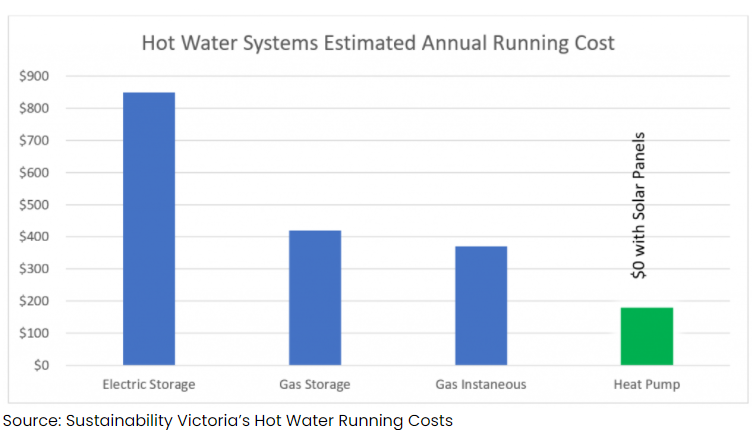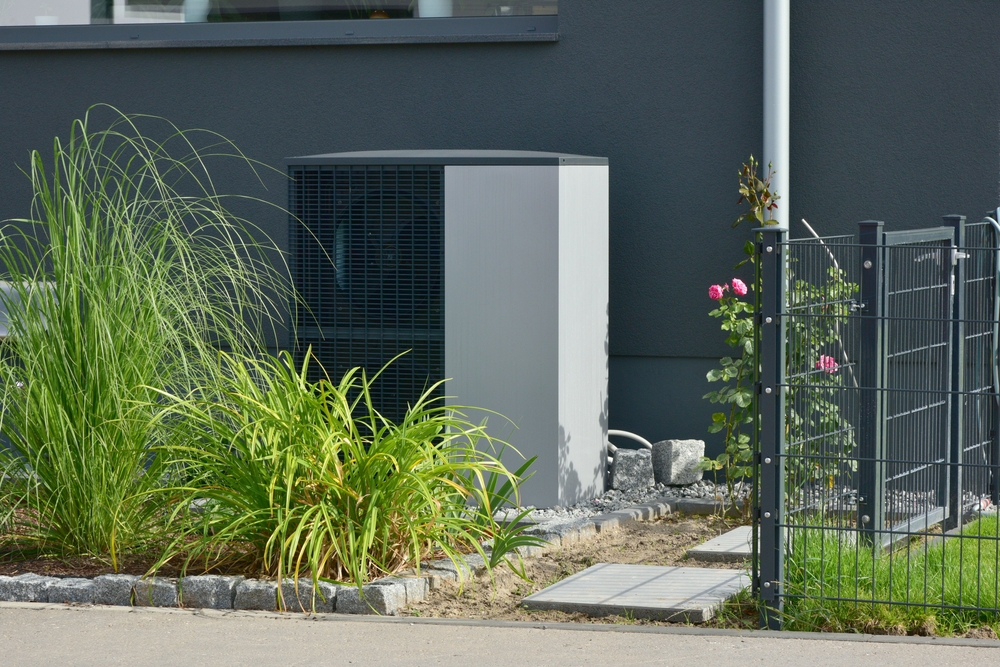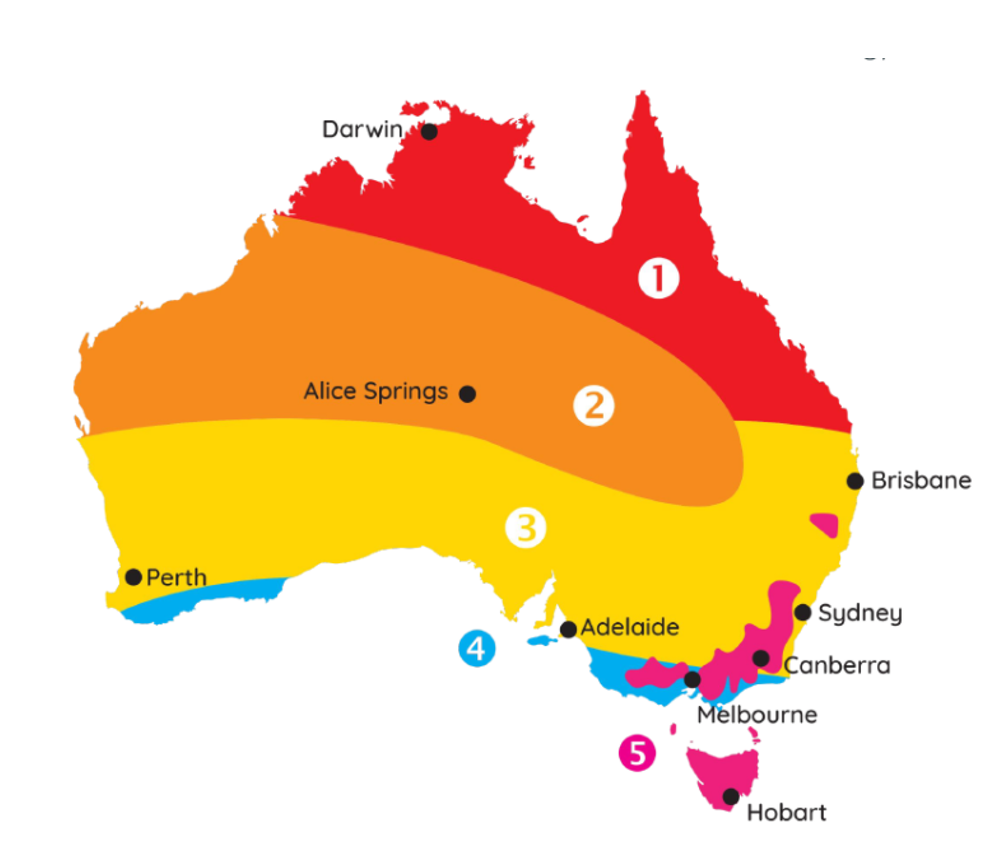We all love a good hot shower, but how much is it costing you? Hot water heating currently accounts for 21% of total energy usage for the typical Australian home. Most of us are paying hundreds of dollars more than necessary every year for our hot water. The culprit is the out-dated hot water systems in our homes – both conventional resistive electric hot water systems and gas hot water systems.
Fortunately, technology has progressed. Now, it’s widely acknowledged that most efficient way of heating hot water is with a hot water heat pump. Experts also agree that the best way to reduce your hot water heating costs is to combine the heat pump with a solar panels system. That way your solar system powers your heat pump for free, providing you with plenty of hot water, day and night.
Prices for hot water heat pumps have plummeted in recent years. Combined with attractive government hot water rebates, the upfront cost of installing a quality hot water heat pump system is a lot less than you might expect.
Fill out the form below for personalised recommendations and quotes.

Here are the top reasons why it’s a great idea to install a hot water heat pump.


Combining a hot water heat pump system with solar panels gives you the biggest bill savings. That’s because most heat pump systems come with a built-in automatic timer. You can use the timer to power up your heat pump around midday when the sun is producing the most energy. That way your free solar electricity is providing you with free hot water. It’s the perfect energy-saving, bill-busting combination!
Hot water heat pumps work in the same way as two other heat pumps you probably already have in your home: your air conditioner and your fridge.
They all work by:
The process concentrates heat, rather than creating more heat. That’s why hot water heat pumps are more energy efficient that conventional electric hot water systems.
Good heat pumps work effectively even in freezing weather. If you buy a heat pump that’s approved for your climate zone, your heat pump will work efficiently all year around. Recent advances in cold-climate heat pump technology mean you can use a heat pump no matter where you live – even in the coldest parts of Australia.
You’re unlikely to run out of hot water with a correctly sized heat pump. But it’s good to know that heat pumps can heat hot water quickly. Depending on the model some units can heat 50L within 15 minutes.
Heat pumps do make some noise. Better quality heat pump systems are around 37-40 decibels, like the sound of a modern indoor fan.
If you’ve got an old electric hot water system, upgrading to a heat pump hot water system is a no-brainer. That’s because your hot water energy costs will reduce by around 80%, depending on the type of heat pump hot water system installed. And that’s even before combining your heat pump with a rooftop solar system. What’s more, upgrading from a conventional electric hot water system can attract the highest government rebates.
You’ll also be doing the environment a big favour. Traditional electric hot water systems release 4.75 tonnes of greenhouse gases annually, making them the worst CO2 polluter out of all the hot water systems. In contrast, heat pumps release only 1.6 tonnes of greenhouse gases annually.
Is a hot water heat pump worth it if you currently have a gas hot water system? The answer is YES!
| Hot water system | Annual running cost |
| Gas storage | $410 |
| Gas instantaneous | $365 |
| Heat pump | $185 |
Source: Sustainability Victoria’s Hot Water Running Costs
It’s worth noting that the annual running costs in the above table are a best-case scenario, i.e. they compare the running costs of the most efficient types of systems in each category. For example, if your gas storage system was less than 5.5 star efficiency, the annual running costs would be higher. It’s also important to be aware that the exact running cost for a heat pump depends on the electricity tariff, pump model and hot water usage.
A big downside with gas is that it is likely to get more expensive. Most of our gas is now exported, making gas more expensive for Australian residents.
Gas is also environmentally damaging, given that in Australia it is mostly extracted through hydraulic fracturing, or “fracking” which can poison groundwater and threaten wildlife.
A split heat pump system is preferable to an integrated heat pump system for the following reasons:
More flexible: A split system allows greater flexibility in locating the two components. For example, you could locate the tank indoors and the heat pump mechanism outside on a wall.
Inside/outside installation: Split system heat pumps have the advantage that the tank can be inside while the compressor is outside. This reduces heat losses from the tank in colder climates. It’s also easier to add extra insulation if necessary.
Can be installed in confined spaces: With a split system, the tank can be installed in almost any location including confined spaces. For example, the tank could be installed inside the home or under the house, with the heat pump on an outside wall. An integrated system, on the other hand, needs a large space to allow enough ambient airflow. The unit must be installed outside.
More efficient
Split heat pump systems are generally more efficient than all-in-one systems, with a higher COP rating. The COP rating tells you how efficient the heat pump is at transferring heat compared to the amount of electrical power used to run it. A good quality split heat pump systems should have a COP rating of 3 to 4, meaning that generate 3 to 4 times more energy than it consumes. The higher the COP rating, the less electricity is used to run the system. That’s better for your bank balance and the environment!
Federal government rebates – in the form of Small-scale Technology Certificates (STCs) – are available for approved hot water heat pump systems.
Where you live in Australia will determine the value of your STCs for your new heat pump system. As a rule of thumb the more STCs a heat pump earns in your zone, the more efficiently it will work for you.
As you can see from the chart below, Victoria, Tasmania and southern NSW are the areas where you get highest value STCs for hot water heat pumps. But even if you’re in Queensland or northern NSW, the STC heat pump rebate is still worth having!
| Heat Pump STC Rebate 2022 | ||
| Zone 1 | 22 | $815 |
| Zone 2 | 21 | $780 |
| Zone 3 | 26 | $960 |
| Zone 4 | 28 | $1,040 |
| Zone 5 | 28 | $,1040 |

All Victorian households and businesses that upgrade from an inefficient electric system are eligible for Victorian Energy Efficiency Certificates – known as VEECs. VEECs are a type of rebate with each VEEC representing one tonne of greenhouse gas that has been prevented from entering the atmosphere.
The highest value VEEC rebates are for those converting from an old electric-resistive hot water system – that’s because old electric hot water systems generate the most greenhouse gas emissions.
The great thing about VEECs is that they are in addition to the federal government STC rebates. Melbourne metro households installing an approved hot water heat pump system can get up to $2,580 in combined VEEC and STC rebates, with regional Victorian households getting slightly more.
Victorians get VEEC and STC Rebate
| # VEECs | Value of VEECs | STC rebate | VEECs + STC | |
| Metro | 22 | $1,540 | $1,040 | $2,580 |
| Regional | 24 | $1,680 | $1,040 | $2,720 |
To talk to one of our commercial solar experts, get in touch today. We’ve got the technical and business expertise to help you make the best solar decision for your business.
We are available! Have a question? Text us here.
 Text Us
Text Us